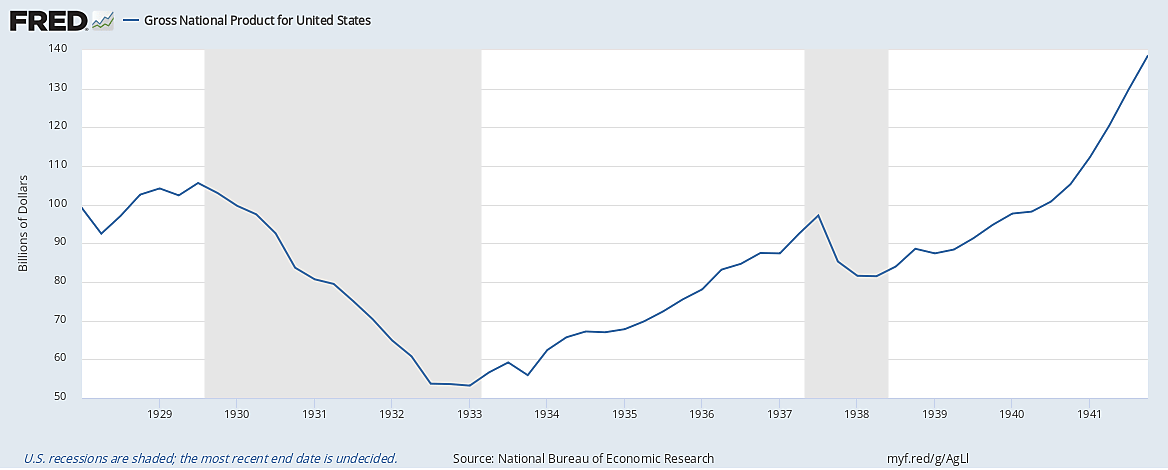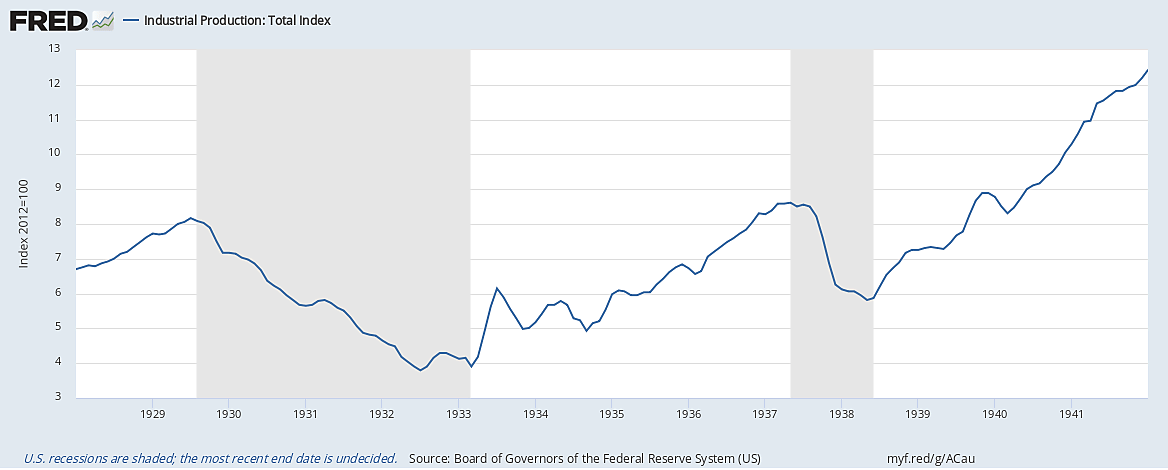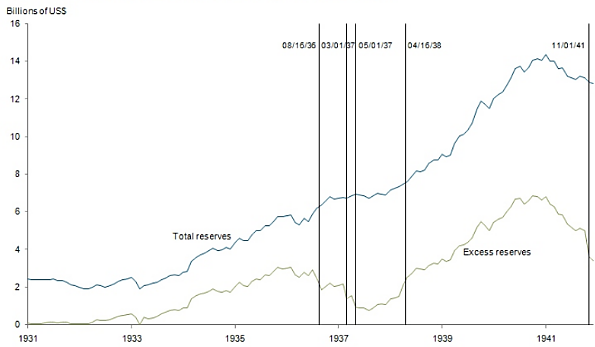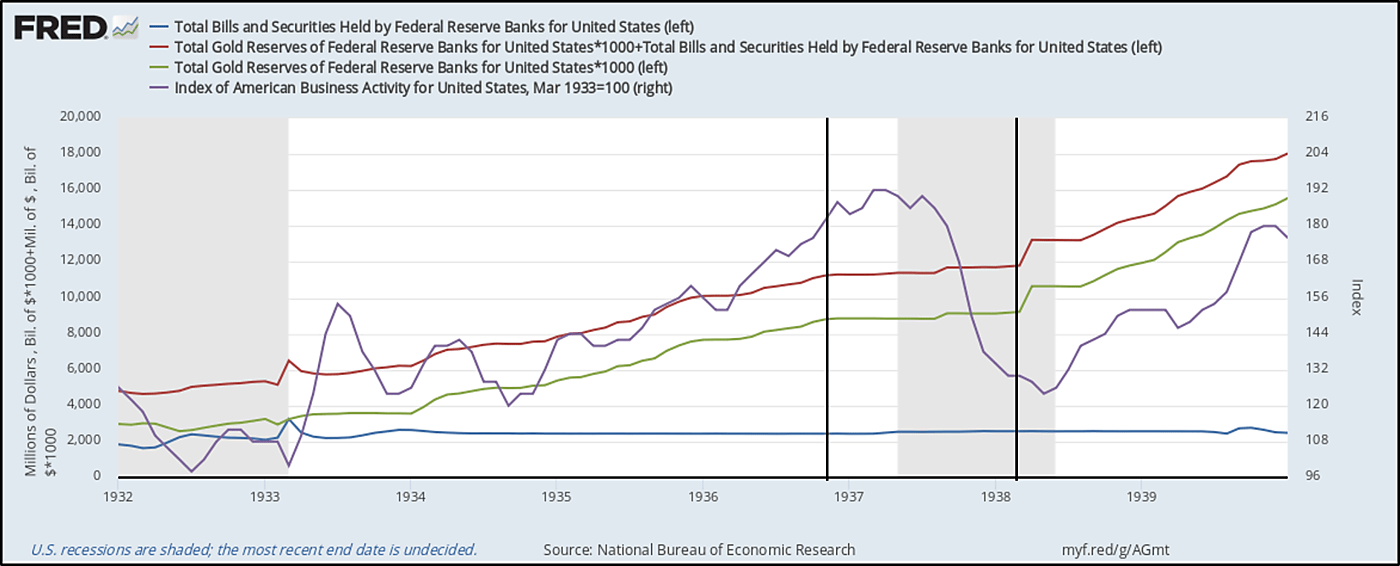By the start of 1937, things were looking up for the U.S. economy. Although the Supreme Court had struck down both the NIRA and the AAA—the chief pillars of the original New Deal’s recovery plan—some time earlier, like a glider released by its tow plane, the recovery itself kept going.
Indeed, the glider analogy doesn’t quite work, because instead of gradually declining, economic activity started rising faster than ever: whereas in 1934 and 1935 real GNP grew by 7.7 and 8.1 percent, respectively, in 1936 it grew by a whopping 14.1 percent. Between May 1935, when the NIRA was struck down, and April 1937, unemployment fell by a third—as compared to a 28 percent decline while the NRA codes were in effect. Bank lending, long stagnant, also started to revive. And the stock market, which bounced around but otherwise made little headway while the NRA did its thing, rose by a hefty 70 percent.[1]
Nor was this improvement at all mysterious. As I explained in an earlier post, instead of promoting recovery as it was supposed to, the NRA codes held it back. It’s therefore not surprising that, by sweeping them off the books in May 1935, and thereby allowing the U.S. economy to make better use of the gold inflows from Europe that were really nursing it to health, the Supreme Court actually did more to promote recovery than the NRA itself had done.
A False Dawn
Things were so good, in fact, that many believed the long-awaited recovery to be just around the corner. FDR must have thought so, or else he wouldn’t have reminded Congress that January that “Your task and mine is not ending with the end of the depression.”
But such optimism didn’t last long. In May, according to the NBER’s business cycle chronology, the economy started shrinking again. Expenditures fell; inventories accumulated; and profits dwindled. Soon it was obvious to all that the U.S. was in the throes of yet another severe recession. By the time it was over, in June 1938, real U.S. GNP had fallen by 18.2 percent. That was less than the 26.6 percent decline suffered in the early years of the depression. But as is clear from the chart below, it happened much more quickly, and was in that respect even more stunning. The setback was also severe enough to undo a substantial part of the gains achieved since FDR took office.
Bad as the quarterly GNP numbers look, they still don’t accurately convey the extreme nature of the 1937 downturn. Because that downturn was so steep and short-lived, quarterly data can’t do it full justice. To come closer we need to look at industrial production. Although it tracks the nominal output of manufacturing firms, mines, and utilities only—a small portion of the U.S. economy taken as a whole—that statistic has the advantage of being measured every month. Between May 1937 and June 1938, industrial production fell by almost one third—a truly stupendous drop.
What came to be known as the “Roosevelt Recession,” especially among FDR’s detractors, has posed a challenge to economic historians. But unlike the challenge of explaining the 1929 downturn, the problem in this case consists not of a lack but of a surfeit of plausible culprits—a very different sort of whodunit.
Fear of ‘Flating
Most accounts of the 1937 crash blame it on demand-side shocks, and particularly on a sudden switch to less expansionary, if not contractionary, monetary and fiscal policies. The switch was partly informed by the belief that full recovery was in sight, and the fact that the markets for stocks and some commodities were already booming. But it was also a reaction to banks’ large holdings of excess reserves. Together these developments suggested to many that, unless steps were taken to prevent it, the United States was headed straight for what Federal Reserve Chairman Marriner Eccles called a “dangerous inflation.” Eccles’ worries were shared by many administration officials, including FDR. “I am concerned—we are all concerned,” he told the press that April, “over the price rise in certain materials.”
Dangerous inflation? In retrospect at least, officials’ fear seems tragi-comic. Far from being something to be dreaded, inflation sufficient to get prices back to their 1926 level had long been one of FDR’s main objectives. One could even say that he regarded its achievement as the sum and substance of a complete recovery. But in the late spring of 1937 the Consumer Price Index was still about 20 percent below its level in mid-1926. And if that wasn’t proof enough that the recovery was far from complete—that the country still had a way to go before “reflation” gave way to inflation proper—there was the fact that the conventionally-measured unemployment rate, which counted those working in government relief programs as “unemployed,” was still in the double-digits. Upon hearing that American officials had begun to worry about inflation, Keynes is supposed to have quipped that they “professed to fear that for which they dared not hope.”
Alas, those officials were in earnest; and their fears soon led to action. What particularly concerned them was the reserve stockpile banks had accumulated since the bank holiday, a large part of which consisted of “excess” reserves, meaning reserves beyond banks’ mandatory requirements. Fed officials feared that, as the recovery continued, a revived demand for credit would lead first to a rapid expansion of bank lending and the money stock, and thence to the “dangerous inflation” Eccles warned about. That European gold—“hot money”—was now flowing into the U.S. faster than ever, and that the Fed’s limited security holdings would prevent it from using open-market sales to keep that inflow from adding to banks’ superfluous reserves, only made the need for other action seem that much more acute.[2]
Although the Fed’s open-market powers were limited, thanks to the Banking Act of 1935 it had another trick up its sleeve: the power to as much as double its member banks’ minimum reserve requirements. Fed officials now chose to put that power to use. On Bastille Day, 1936, a divided Board of Governors voted to raise member bank reserve requirements by 50 percent effective August 15th. Because rates didn’t budge, and gold kept pouring into the country, sentiment grew in favor of further increases. Finally, at the end of January 1937, the Board elected to raise the requirements by another third—the maximum level allowed—this time in two half steps to be taken on March 6th and May 1st, respectively. The vertical lines in the following chart, showing the behavior of total and excess bank reserves between 1931 and 1942, mark the dates of the three increases.
A Doubling Debacle
While the Fed’s first two reserve-requirement increases seemed to do little harm, the third almost perfectly coincided with the start of the ’37 downturn. According to many experts, this was no coincidence. So far as they’re concerned, instead of merely serving to head-off inflation, the Fed’s decision to double reserve requirements was one of the chief causes, if not the cause, of the 1937 collapse.
How so? In essence, the argument—which owes its popularity to Milton Friedman and Anna Schwartz’ development of it in their Monetary History of the United States—is that while Fed officials viewed excess reserves as “redundant” reserves, the banks themselves didn’t see them so. Instead, having been traumatized by runs in the early years of the depression, they accumulated excess reserves deliberately, for safety’s sake: unlike required reserves, excess reserves could be used to meet runs without risk of legal penalties. Thanks to low interest rates, this precaution, besides being prudent, was also cheap.[3]
So when the Fed increased banks’ required reserves, and especially when it did so for the third time, instead of doing nothing the banks sought to rebuild their excess reserve cushions. With only so many reserves in the system, this meant limiting their required reserves by shrinking the non-reserve components of their balance sheets: loans, investments, and deposits. The resulting decline in bank credit and the money stock helped bring about the 1937–8 recession, just as the Great Monetary Contraction of 1929–33 led (once again, according to Friedman and Schwartz) to the first Great Depression downturn.
Reserve-ations
Popular as it is, the theory that the Fed triggered the ’37 collapse by raising banks’ reserve requirements has never lacked critics. Unsurprisingly, those Fed officials who argued for the policy, including Lauchlin Currie, the Board’s chief economic advisor, denied that it restricted the supply of credit, or otherwise contributed to the recession. Nor were they alone among their contemporaries in taking that view. According to Benjamin Anderson, who served as Chase National Bank’s chief economist during the depression,
Reducing the [banks’] excess reserves could not reduce the volume of business unless real differences were made thereby in interest rates, and unless restrictions were imposed thereby upon the use of money and credit. Now the evidence is overwhelming that nothing of this sort occurred.
Several more recent writings have drawn renewed attention to and supplemented the evidence Anderson had in mind. In a 2001 article L.G. Telser showed that, instead of lending less, Fed member banks met their increased reserve requirements by selling government securities, ruling out the possibility that the Fed’s actions triggered a credit crunch. A decade later, upon examining data for individual Fed member banks, Charles Calomiris, Joseph Mason, and David Wheelock (2011) found that, even after they’d been doubled, the Fed’s “reserve requirements were not binding on bank reserve demand in 1936 and 1937, and therefore could not have produced a significant contraction in the money multiplier.” Instead, they conclude that, contrary to the Friedman and Schwartz hypothesis, such increases in reserve demand as took place from June 1936 to June 1937 “reflected predictable influences related to the structure of the banks, and not increases in reserve requirements imposed by the Fed.” Finally, Haelim Park and Patrick Van Horn (2014) also find that Fed’s reserve requirement changes didn’t lead member banks to reduce their lending. They therefore conclude that “the actions of the Federal Reserve…cannot be blamed for instigating the economic downturn of 1937–38.”
And a Rejoinder
But Friedman and Schwartz’ critics may not have the last word. Instead, their arguments have been questioned in turn by Gauti Eggertsson and Benjamin Pugsley (2006), who claim that the Fed’s doubling of reserve requirements contributed to the 1937 downturn even though it didn’t lead to any substantial decline in bank lending or the money stock, or to any substantial or lasting increase in short-term interest rates. In their view, the Fed’s decision mattered not because it led to an immediate tightening of credit but because it was the first important sign that the government was reversing its stance on inflation: having long promised to get prices back to their pre-depression levels, and despite not having yet reached that goal, government officials now seemed determined to put a lid on inflation.
Eggertsson and Pugsley consider this official about-face “one of the most peculiar policy mistakes in U.S. economic history.” But they regard it so not because it led to any immediate clamping-down on credit, but because it “created pessimistic expectations of future growth and price inflation that fed into both an expected and an actual deflation.” Nominal rigidities, finally, caused the collapse in prices to be accompanied by an equally severe contraction of output.
Using a dynamic stochastic general equilibrium (DSGE) model, Eggertsson and Pugsley show that, far from depending on any increase in current short-term interest rates (as opposed to expectations of future rate increases), such an expectations-driven downturn can be “particularly damaging at zero interest rates.” Because it’s immune to the objection that monetary policy can only matter if it leads to immediate changes in bank lending, money growth, and short-term rates, the Eggertsson and Pugsley thesis gives “monetary” explanations of the 1937 downturn a new lease on life.
Rebirth Control
The Fed’s doubling of reserve requirements was but one of two monetary policy changes that may have contributed to the Roosevelt Recession, whether through an expectations channel or otherwise. The other, which some consider more important, and which was also part of the government’s effort to forestall inflation, was the Treasury’s decision to “sterilize” gold inflows.
In fact, Friedman and Schwartz themselves viewed the Treasury’s gold sterilization program as being just as important a cause of the contraction of ’37 as the Fed’s reserve requirement increases. The Treasury had nevertheless been cast in most accounts since as the Fed’s less important accomplice. But in a 2012 paper Dartmouth economic historian Doug Irwin makes a strong case for giving the Treasury pride of place.
As we’ve seen, after 1933 gold fleeing Europe for the U.S. was the chief cause of overall demand growth and, starting in 1935, of concerns that the U.S. was headed toward unwanted inflation. The Fed could do nothing to prevent the gold inflow from adding to banks’ reserves; but it could and it did force banks to hold on to those extra reserves. The Treasury, on the other hand, could sever the link between increases in the total U.S. gold stock and increases in the monetary gold stock, where the last alone contributed to bank reserves. Normally, after drawing on its Fed balance to pay to buy gold at the official price of $35 an ounce, the Treasury would replenish its account by depositing an equivalent sum in gold certificates. The monetary gold stock and monetary base would then grow in step with the total gold stock. To sever the link, and thereby “sterilize” the gold inflows, the Treasury had merely to quit printing and depositing a like value of gold certificates for every ounce of gold it purchased.
And from December 1936 until February 1938, excepting a one-time “desterilization” of $300 million in September 1937, the Treasury did just that, with the express aim of “halt[ing] the inflationary potentialities” of incoming gold. As the next FRED chart shows, because the Fed itself extended very little credit during the sterilization period, the Treasury’s policy slammed the brakes on the monetary base growth that had been promoting recovery, to the extent that other New Deal policies allowed it to, since 1934. The chart also makes clear the close coincidence, allowing for a short lag, between the start and finish of the Treasury’s policy and the beginning and end of the 1937–8 recession as reflected in Ayres’ Business Activity index.
According to Irwin, the Treasury’s sterilization policy was far more contractionary than the Fed’s reserve-requirement increases, partly owing to the fact that reserve requirements were less binding than Friedman and Schwartz and others have supposed, but also because the change in the growth rate of the monetary base, from an average annualized rate of 17 percent between 1934 and 1936 to zero, was far greater than the concurrent change in the money multiplier. For this and other reasons, including its timing, Irwin concludes that the Treasury’s policy played the more important role in the 1937–8 recession.[4]
But it was, after all, the combined effects of the Fed and Treasury actions, rather than the relative importance of each, that really matters. And here it’s worth noting that each player acted rather as if it didn’t know, or didn’t care, what the other was up to! While both Marriner Eccles and Treasury Secretary Henry Morgenthau saw a need to clamp down on money growth to head-off inflation, Eccles favored doing so by raising the Fed’s reserve requirements, while Morgenthau tried to convince him that sterilizing gold inflows was the better policy. Instead of coming to an agreement, or otherwise coordinating their policies, Eccles went ahead with the Fed’s first reserve requirement increase without bothering to tell Morgenthau, let alone gain his approval. When that increase seemed to make little difference, Morgenthau proceeded with his sterilization program, after securing Eccles’ last minute and grudging endorsement. Then, despite Morgenthau’s expressed reservations, Eccles in turn went ahead with Fed’s further reserve requirement increases. It is as though two doctors, sharing the same overanxious patient, each insisted on administering a strong sedative, whether the other did so or not, and ended up rendering her unconscious.
But here again, my analogy falls short, because it’s far from obvious that the U.S. economy needed a sedative at all. It fails in another respect as well. For instead of just getting a double-dose of sedatives, the U.S. economy got several. Just what those other sedatives were, and how they contributed to the economic collapse, will be the subjects of my next installment.
Continue Reading The New Deal and Recovery:
- Intro
- Part 1: The Record
- Part 2: Inventing the New Deal
- Part 3: The Fiscal Stimulus Myth
- Part 4: FDR’s Fed
- Part 5: The Banking Crises
- Part 6: The National Banking Holiday
- Part 7: FDR and Gold
- Part 8: The NRA
- Part 8 (Supplement): The Brookings Report
- Part 9: The AAA
- Part 10: The Roosevelt Recession
___________________
[1] For more on the slow and erratic progress of recovery while the first New Deal was in effect see Garfield Cox (1936, p. 2). Referring to that progress as measured by Leonard Ayres’ index of American Business Activity (which closely follows the more frequently cited index of industrial production), Cox notes that whereas “all previous recoveries, once started, have brought [that index] back to normal rather quickly,” with the longest delay taking just 14 months, “this time after 33 months this index is still substantially below trend.” Furthermore, “no previous recovery from depression has been punctuated by reversals so extensive as those which have interrupted the current expansion.” Cox also notes (ibid., p. 3) that “in no recovery in eighty years have iron and steel and durable goods in general lagged as they have from 1933 to 1935.” These were, of course, among the sectors most influenced by NRA codes.
[2] Several factors contributed to the Fed’s limited capacity to offset gold-based reserve growth through open market sales. One was that by mid-1936, member bank excess reserves exceeded the Fed’s government securities of just over $2.4 billion. Another was that the Fed relied upon income generated by those securities to pay its operating expenses.
[3] For further developments of the argument that banks’ had a genuine demand for excess reserves see Frost 1971 and Wilcox 1984.
[4] Concerning Eggertsson and Pugsley’s claim that the bearing of the Fed’s reserve requirement changes on expectations made those changes much more potent than they might have been otherwise, Irwin observes (p. 250n7) that “[i]t seems implausible to think that ‘animal spirits’ could sink the economy as much as occurred during 1937–8 in the absence of some tangible change in government policy or some real shock.” This seems rather unfair to Eggertsson and Pugsley, who never suggest otherwise. Instead they claim only that expectation effects further magnified the consequences of “tangible” policy changes, including both the Fed’s reserve requirement increases and the Treasury’s sterilization policy.
[Cross-posted from Alt‑M.org]






